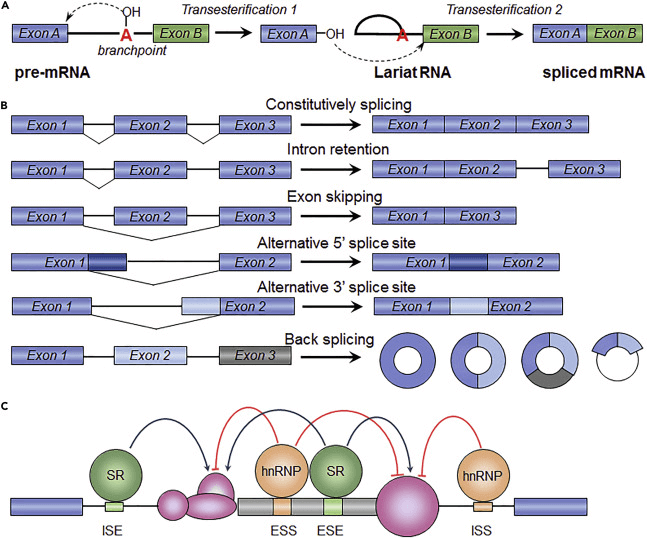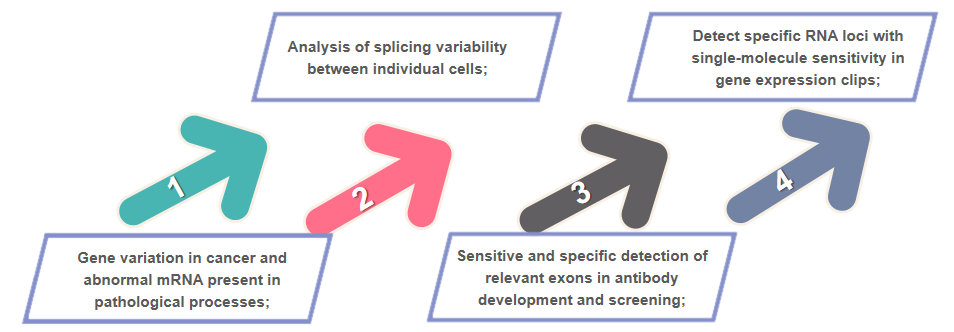Short Sequences and Splice Variants in RNA Splicing
RNA splicing is a fundamental regulatory process of gene expression and plays a key role in transcriptome complexity, cell fate determination, and the development of organisms, especially immune cells. The detection of splicing products is of great importance because aberrant splicing can lead to cellular dysfunction and various diseases, such as cancer and neurodegenerative diseases. In particular, splicing variability between individual cells is largely responsible for gene expression heterogeneity. The study of the single-cell expression of RNA splice variants provides a venue for addressing gene regulatory circuits, mapping intracellular localization, and classifying cell types. Common in vitro methods can provide a wealth of information about transcriptome composition and quantification, but a large amount of information can be lost when total RNA is extracted. Non-selective cell lysis affects the analysis of biologically significant rare cell populations, and information on spatial distribution cannot be recovered from in vitro assays. Therefore, techniques for in situ visual analysis of RNA splice variants in single cells can provide additional knowledge. Single-cell techniques can provide relative expression levels, intracellular localization, and regulatory network correlations that will further improve our understanding of transcriptome complexity and genetic and epigenetic mechanisms, and guide disease diagnosis and treatment.
 Fig 1. RNA Splicing and Its Regulation. (Xiaojun Ren, et al. 2019)
Fig 1. RNA Splicing and Its Regulation. (Xiaojun Ren, et al. 2019)
In Situ Visualization Analysis Solutions for RNA Splicings
For in situ analysis of RNA clips, we provide separate experimental protocols for in vitro and in vivo analysis. The methods of in vivo characterization are mainly cell imaging with fluorescent probes and Flow-FISH. In situ hybridization analysis using fluorescent probes and fluorescence microscopy enables visualization of differential gene expression in single cells. In addition, through the powerful analytical capabilities of flow cytometry, quantitative analysis can be achieved using commercial probes or custom probes. For in vitro analysis protocols, in vitro characterization methods are mainly achieved by in situ hybridization, and many adapted FISH variants are available on our experimental platform. Through internal optimization, we can use a variety of commercial probes for analytical testing, including full-process customization of personalized custom probes. Commercially available probes enable the detection of exon junctions using only one uniquely designed probe at the specific exon junction of interest. Analysis methods via fluorescence resonance energy transfer (FRET) probes are also included in the various protocols we offer.
Applications
RNA splicing in immune cells, sensitive and specific detection of relevant exons in antibody development and screening;
Analysis of specific RNA loci at the single-cell level in gene expression editing;
Analysis of gene variants in cancer and abnormal mRNA present in pathological processes;
Analyze a wide range of sample types, including live cells, FFPE tissue, and fresh frozen tissue;
Analysis of splicing variability between individual cells;
 Fig 2. Features of the RNA splicing analysis visualization service.
Fig 2. Features of the RNA splicing analysis visualization service.
Creative Bioarray provides an in situ visualization analysis solution for RNA cleavage, helping researchers analyze RNA cleavage during gene expression in situ from the single-cell level or tissue. A wide variety of commercial probes and our robust adaptable solutions provide you with one-stop analytical testing. If you are interested in our FISH service, please contact us for cooperation. We look forward to cooperating with you in the near future.
Reference
- Ren, Xiaojun, et al. "RNA splicing analysis: from in vitro testing to single-cell imaging." Chem 5.10 (2019): 2571-2592.


 Fig 1. RNA Splicing and Its Regulation. (Xiaojun Ren, et al. 2019)
Fig 1. RNA Splicing and Its Regulation. (Xiaojun Ren, et al. 2019) Fig 2. Features of the RNA splicing analysis visualization service.
Fig 2. Features of the RNA splicing analysis visualization service.


